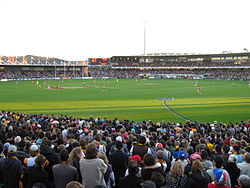Australian rules football in Tasmania
| Australian rules football in Tasmania | |
|---|---|

An AFL match in progress at Aurora Stadium in Launceston between two Melbourne based teams - Hawthorn Hawks and the Western Bulldogs in 2008 attracts a crowd of 19,378 fans.
|
|
| Governing body | AFL Tasmania |
| Representative team | Tasmania |
| First played | 1864 New Town |
| Registered players | 32,138 (total) 4,500 (adult) |
|
Club competitions
|
|
|
List
|
|
|
Audience records
|
|
| Single match | 24,968 (1979). TFL Grand Final Glenorchy v Clarence (North Hobart Oval, Hobart) |
Australian rules football in Tasmania known as "football" officially and locally, has a history dating back to the 1860s, with the state having the distinction of being the first place outside of Victoria to play the sport.
Despite not being represented in a national competition, it remains the most popular sport in the state, and has the second highest participation rate in the country.
Organised "Foot-ball" matches have been recorded in Van Diemens Land since 1851 and matches in southern Tasmanian towns of Hobart and Richmond between 1853 and 1855 significantly pre-date those recorded across Bass Strait in suburban Melbourne.
Sean Fagan claims that early matches played in Tasmania may have been an early form of rugby football, pointing to early mentions of goal posts with cross-bars and offside rules of later Tasmanian clubs.
However, apart from the fact that they were organised and played, few details of these matches actually survive, and the popularity of football in the fast-growing colony of Victoria quickly eclipsed the following that the pastime had in newly named colony of Tasmania.
The "football" club formed in New Town in 1864 is believed to be the earliest in Tasmania - but disbanded soon after. By the mid- to late 1860s, more stable clubs, including Derwent and Stowell Football, emerged.
It was not until the adoption of "Victorian Football Rules" in 1866 that Tasmanian football was properly organised and recognised, and even by then some clubs may have for a brief time continued playing by their own rules.
In 1871 the Break O'Day club was formed and in 1875 the Launceston Club was created. Other clubs to start soon after were Longford (1878), Launceston Church Grammar School (1876) and Cornwall (1879), which became City in 1880. The City and Richmond clubs were formed in 1877 and the Oatlands and Railway clubs in 1879.
...
Wikipedia
